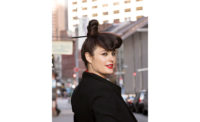Newsmaker Interview: Eva Kotátková




















The annual Frieze New York art fair took place last weekend, and as usual, conditions inside the quarter-mile-long tent that houses the event felt a bit overstimulating. Inside the brightly lit belly of the temporary structure, a snaking white form designed by Brooklyn firm SO–IL, visitors bounced among 190 booths where dealers presented work in eye-catching installations arranged to command maximum attention from collectors. In general, the experience imparted a manic energy. But outside, Czech artist Eva Kotátková offered a more soporific example of the environment acting on the body.
Alongside the tent, three metal objects rose from platforms set on a lawn by the bank of the East River. Wiry abstractions, two hung with fraying rope, they looked like a cross between generic public sculpture and playground equipment. Perched on each of them, a performer, propped up by the shape of the installation, appeared to doze—occasionally tossing and turning like a somnambulant gymnast or swinging languidly, all in a precarious dance.
The installation, titled The Architecture of Sleep (2014), was presented by Frieze Projects, a series of pieces commissioned in tandem with the fair, and it picks up on strategies common to much of the artist’s work. Kotátková often builds environments that contort or ensnare the bodies of performers using cage-like geometric forms—as well as various other furniture-size contraptions—invoking Kafkaesque struggles against ill-defined controlling forces.
RECORD spoke with Kotátková about her installation at Frieze, how she envisions these encounters between body and built structure, and the spaces that inspire her work.
Why did you begin building installations that manipulate performers’ bodies?
I’m interested in questioning “cages”—those that we carry in ourselves as well as those that the society builds around us. I create systems in which one can walk around and try to define a position, or where one can get completely lost. I’ve realized several works that borrowed specific architectural diagrams, divisions of space that often demonstrate given hierarchies (for example, the institutions of the Communist era in my country), and attempted to show how the body moves within them, how it is trapped or how it tries to revolt or escape.
In fact, I have been collecting rules from specific institutions for some time, rules that dictate how to behave in various structured environments, such as schools, hospitals, prisons, parks, zoos…I realized that people’s biographies could be translated into a chronological list of institutions, as if only in the transition between one institution and another does a person have the chance for free movement.
What are some of the particular spaces that have influenced you?
I have worked in various environments—in a school, realizing a project with pupils, in a psychiatric clinic. But the starting point was my own home and its private domestic sphere, limited to the floor plan of a room, a desk, a table. This is something I often reference in my work, and I actually never start to work in a studio, I prefer a kitchen table.
What sort of environments led to The Architecture of Sleep?
I haven’t done too many outdoor installations in my previous work, so the site [on Randalls Island, in the middle of the East River, near Manhattan] was extremely interesting and challenging. It has many different kinds of sites to respond to—from a loud sports stadium to a bird sanctuary to a strangely quiet psychiatric hospital.
Each object in the work is meant to represent a different stage of the sleep cycle. The metal welded structures are activated and completed by performers sitting, hanging, laying, moving, or exercising on them. They resemble playground structures as well as strange devices for the body—torture or exercise devices.
The aim is that one does not perceive the work as a performance situated on metal structures but that you encounter something that is part body and part object. The structures manipulate the body and how it moves, limiting the poses and placing it in often uncomfortable positions. Though from time to time, the body revolts and moves against the object by not copying its silhouette.

